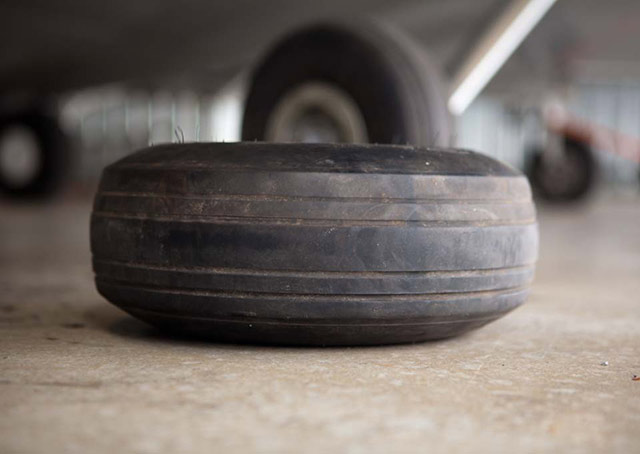
Aircraft tires are extremely resilient and reliable, but they’re also critically important to safe takeoffs and landings. A flat tire on an airplane can cause a routine landing to turn very ugly in a split second. Consider that landing gear-up almost never causes a loss of control of the aircraft and injury to the people on board, but landing gear-down with a blown, flat, or severely damaged tire frequently results in loss of control during the landing and puts everyone on board at risk.
 Here are 10 tips that can help you get the most from your tires, fly as safely as possible, and take good care of our round rubber friends.
Here are 10 tips that can help you get the most from your tires, fly as safely as possible, and take good care of our round rubber friends.
- Preflight the entire tire—Most pilots will give a cursory glance to the tires on their preflight inspection. If the aircraft has wheel pants, they might not even do that. The problem is that when a tire has a flat spot or damage from a lock-up on landing, it is often limited to a very small section of the tire. So, be sure to roll the aircraft during the inspection to reveal the entire tire for inspection.
- Polish your crosswind technique—If you want to run through a good set of tires quickly, simply use the runway surface to straighten out your landing crab for you. Poor landing technique on just a few landings can be responsible for more lost rubber than a hundred good landings. So, spend some time with a good instructor learning (again) when to use a crab versus wing-low approach to landing and how to correct it properly just before the tires hit the runway.
- Check your tire pressure—Underinflation puts enormous stresses on the tire. At high speeds, the tire flexes much more than normal, causing torsional stresses that can literally twist the tire between the wheel and the tread. It also causes a buildup of heat and can induce hydroplaning in conditions that a properly inflated tire would not. Minor overinflation, in contrast, can cause accelerated wear on the center tread, but is much less likely to cause severe issues.
- Don’t simply walk away from a tough landing—Bad landings happen to all of us; what matters is what happens afterward. If you feel the aircraft skidding during the landing, or if you have to brake heavily enough to cause a tire to temporarily lock or skip, you need to conduct a careful postflight inspection of the tire. Just as noted about preflights, this means inspecting the entire tire, not just the part you see after parking. If you discover a flat spot, just accept that it’s time for a new tire. The cost of a new tire versus the cost of a blow-out is not comparable.
- Buy the right tire for your mission—How do you fly? If you fly on longer trips, it’s likely that time is more important than tread when it comes to the longevity of the tire. Consider investing in a premium tire that will stand the test of time with the best UV exposure, etc. If you’re an around-the-patch pilot, then you need tread…lots of it. Consider retreads or an inexpensive tire. You may be changing them more often, but you won’t be tossing the most expensive tires out each time.
- Consider balancing—Contrary to popular practice, aircraft tires can be balanced. Lining up the red dot on the tire with the tube valve stem during installation is standard practice, and good enough for most situations. However, if your aircraft has high landing speeds and you have some vibration, you may be surprised by the difference that balancing can make. You can balance them either statically or dynamically. Dynamic balancing is easiest to do if you can find a local auto or motorcycle shop that has the equipment to fit a small wheel.
- Check for proper mounting—If you look closely at a tire near where it meets the wheel you will see a raised line that runs the circumference of the tire. This is a check line that is built into the tire to allow for a visual inspection to ensure that the tire is properly seated and centered on the wheel. Residue, lack of lubrication, or wheel imperfections can cause a tire to hang up on the wheel during installation. So, look closely at the tire/wheel junction to ensure everything is right before mounting the assembly on the aircraft.
- Listen to your tires—Tires often telegraph issues right through your rudder pedals. If you feel a “loping” of the aircraft or a wing up/down during slow taxiing, it means that there is an out-of-round issue with the tire (or a serious issue with the taxiway). Loping can be caused by a mounting issue, a flat spot on the tire, or an out of round tire. It also can be caused by a temporary flat spot from the parking position of the tire, but that should resolve quickly after some taxiing. If the issue doesn’t go away, you need to look closer. Vibrations at higher speeds are more likely to be balance issues or landing gear issues.
- Lube it up—There is a reason that you get a packet of tire talc when you purchase a new tire and tube. Lubrication is essential to proper tire mounting. Use plenty of talc on the inside of the tire, the outside of the tube, and around the tire bead area so it slides easily up the wheel during inflation. And, don’t use regular drug store talcum powder as those products frequently contain additives that can be detrimental to the life of the tube.
- Learn how to change your own tires—If you really want to save some money and get to know your airplane better, I can’t think of a better task than changing your own tires. It’s a legal preventive maintenance item for aircraft owners/operators to do themselves. However, take the time to get proper instruction and always use the proper tools, especially for bead breaking during tire removal. Don’t let a little frustration and the wrong tools cost you a set of new wheels.
Happy flying!
Interested in aircraft maintenance? View the archives of Jeff Simon’s Aircraft Maintenance series.
Jeff Simon is an A&P mechanic, pilot, and aircraft owner. He has spent the last 14 years promoting owner-assisted aircraft maintenance as a columnist for several major aviation publications and through his how-to DVD series: The Educated Owner. Jeff is also the creator of SocialFlight, the free mobile app and website that maps over 20,000 aviation events, airport restaurants, and educational aviation videos, including many how-to videos for the subjects of these articles. Free apps available for iPhone, iPad and Android, and on the Web at www.SocialFlight.com.



